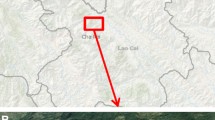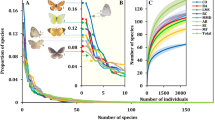Abstract
An extensive follow-up study of day- and night-active Macrolepidoptera was performed during 2004 at the Kullaberg Nature Reserve located in the south-western part of Sweden. Butterflies were surveyed in an area of 100 km2 and night-active moths were trapped in the core area of the reserve. Macrolepidopteran species resident in the area in the 1950s were compared with species resident in the area in 2004. As much as 159 of 597 species (27%) resident in the area in 1950s were not found at all in 2004 and 22 species (4%) had colonised the area. Butterflies exhibited a disastrous decline with a loss of 45% of the fauna, and day-active species had declined more than night-active species had. Species distribution pattern and species characteristics were used to predict the probability that a species had become extinct or colonised the area. Species limited to one or a few food plants, with a short flight-period or restricted to non-forest habitats were all associated with a high extinction risk. Species occurring in fewer European countries and recorded from few provinces in Sweden were all associated with a higher extinction risk compared with ubiquitous species. For expanding species (colonisers), the best predictor was their distribution area in Sweden and colonising species were more likely to be limited to a few provinces in the southernmost part of Sweden. Species extinct from Kullaberg also have decreased in Finland and species that had colonised Kullaberg also have increased in Finland, while the species with no change in Kullaberg are also relatively constant in Finland. Indeed, the macrolepidopteran fauna was severely reduced in the last 50 years and almost 70% of the habitat specialists were lost. For red-listed species the situation was found to be alarming. Almost 70% of red-listed species, resident in the area in the 1950s, was not found in 2004. This study highlights that species composition changes rapidly even in protected nature reserves and that similar changes in the macrolepidopteran fauna seem to occur over large areas.




Similar content being viewed by others
References
Ahrland S, Brinck P (1991). Natur och kultur kring Kullen—ett symposium 31 maj 1989 med anledning av AB Kullabergs natur 75 år. Kungl. Fysiografiska sällskapet, Lund [In Swedish]
Araujo MB, Cabeza M, Thuiller W, Hannah L, Williams PH (2004). Would climate change drive species out of reserves? An assessment of existing reserve-selection methods. Global Change Biol 10:1618–1626
Asher J, Warren MS, Fox R, Harding P, Jeffcoate G, Jeffcoate S (2001). The millennium atlas of butterflies in Britain and Ireland. Oxford University Press, Oxford
Conrad KF, Woiwod IP, Perry JN (2002). Long-term decline in abundance and distribution of the garden tiger moth (Arctia caja) in Great Britain. Biol Conserv 106:329–337
Conrad KF, Woiwood IP, Parson MS, Fox R, Warren MS (2004). Long-term population trends in widespread British moths. J Insect Conserv 8:119–136
Cowley MJR, Thomas CD, Thomas JA, Warren MS (1999). Flight areas of British butterflies: assessing species status and decline. Proc R Soc Lond B 266:1587–1592
Douwes P (2004). Dagfjärilar förr och nu—en studie i Östergötland. Ent Tidskr 125:81–89 [In Swedish]
Eltinge JL, Sribney WM (1997). Versions of mlogit, ologit, and oprobit for survey data. Stata Stat Bull 40:39–42
Emmet AM (1991). Life history and habits of the British Lepidoptera. In: Emmet AM, Heath J (eds) The moths and butterflies of Great Britain and Ireland, vol. 7, Part 2. Harley Books Colchester, pp 61–203
Erhardt A, Thomas JA (1991). Lepidoptera as indicators of change in the semi-natural grasslands of lowland and upland Europe. In: Collins NM, Thomas JA (eds) The conservation of insects and their habitats. Academic Press, London, pp 213–236
Erhardt A (1985). Diurnal Lepidoptera—sensitive indicators of cultivated and abandoned grassland. J Appl Ecol 22:849–861
Gärdenfors U (2000). The 2000 redlist of Swedish species. Swedish Species Information Centre, Uppsala
Henriksen HJ, Kreutzer IB (1982). The butterflies of Scandinavia in nature. Skandinavisk Bogforlag, Odense
Hill JK, Thomas CD, Fox R, Telfer MG, Willis SG, Asher J, Huntley B (2002). Responses of butterflies to twentieth century climate warming: implications for future ranges. Proc R Soc Lond B 269:2163–2171
Hoekstra JM, Boucher TM, Taylor H, Ricketts TH, Roberts C (2005). Confronting a biome crisis: global disparities of habitat loss and protection. Ecol Lett 8:23–29
Huldén L, Albrecht A, Itämies J, Malinen P, Wettenhovi J (2000). Atlas of Finnish Macrolepidoptera. Lepidopterologiska sällskapet i Finland, Helsingfors
Karsholt O, Razowski J (1996). The Lepidoptera of Europe—a distributional checklist. Apollo books, Stenstrup
Kotiaho J, Kaitala V, Komonen A, Päivinen J (2005). Predicting the risk of extinction from shared ecological characteristics. Proc Natl Acad Sci 102:1963–1967
Leinonen R, Söderman G, Itämies J, Rytkonen S, Rutanen I (1998). Intercalibration of different light-traps and bulbs used in moth monitoring in northern Europe. Entomol Fennica 9:37–51
Mace GM, Kershaw M (1997). Extinction risk and rarity on an ecological timescale. In: Kunin WE, Gaston KJ (eds) The Biology of rarity: the causes and consequences of rare-common differences. Chapman & Hall, London, pp 131–149
Maes D, van Dyck H (2001). Butterfly diversity loss in Flanders (north Belgium): Europe’s worst case scenario? Biol Conserv 99:263–276
Mikkola K (1979). Vanishing and declining species of Finnish Lepidoptera. Not Entomol 59:1–9
Mikkola K (1987). Changes in the Finnish Lepidopteran fauna since 1950 in relation to environmental changes. Ent Meddr 55:107–114
Mikkola K (1991). The conservation of insects and their habitats in northern and eastern Europe. In: Collins NM, Thomas JA (eds) The Conservation of insects and their habitats. 15th Symposium of the Royal Entomological Society of London. Academic Press, London, pp 109–119
Mikkola K (1997). Population trends of Finnish Lepidoptera during 1961–1996. Entomol Fennica 8:121–143
New TR (2004). Concluding comment: looking to the future for moths. J Insect Conserv 8:275–276
Nieminen M (1996). Migration of moth species in a network of small islands. Oecologia 108:643–651
Nieminen M, Rita H, Uuvana P (1999). Body size and migration rate in moths. Ecography 22:697–707
Öckinger E, Hammarstedt O, Nilsson SG, Smith HG (2006). The relationship between local extinctions of grassland butterflies and increased soil nitrogen levels. Biol Conserv 128:564–573
Ovaskainen O, Hanski I (2003). Extinction threshold in metapopulation models. Ann Zool Fenn 40:81–97
Ovaskainen O, Hanski I (2004). Metapopulation dynamics in highly fragmented landscapes. In: Hanski I, Gaggiotti OE (eds) Ecology, genetics, and evolution in metapopulations. Academic Press, London, pp 73–104
Parmesan C (2001). Coping with modern times? Insect movement and climate change. In: Woiwood IP, Reynolds DR, Thomas CD (eds) Insect movement: mechanisms and consequences. CABI, Wallingford, pp 387–413
Parmesan C, Root TL, Willig MR (2000). Impacts of extreme weather and climate on terrestrial biota. Bull Am Meteorol Soc 81:443–450
Pollard E, Yates TJ (1993). Monitoring butterflies for ecology and conservation. Chapman and Hall, London
Prendegast JR, Eversham BC (1995). Butterfly diversity in southern Britain: Hotspot losses since 1930. Biol Conserv 72:109–114
Raimondo S, Liebhold AM, Strazanac JS, Butler L (2004). Population synchrony within and among Lepidoptera species in relation to weather, phylogeny, and larval phenology. Ecol Ent 29:96–105
Rassi P, Alanen A, Kanerva T, Mannerkoski I (2001). The 2000 red list of Finnish species. The Ministry of the environment and the Finnish environment institute, Helsinki
Rydén H (1961). Kullabergs storfjärilar. Berling, Lund [In Swedish]
Skou P (1984). Nordens Målare. Danmarks dyreliv. Bind 2. Apollo Books, Stenstrup
Skou P (1991). Nordens ugler. Apollo Books, Stenstrup
Steffan-Dewenter I, Tscharntke T (2000). Butterfly community structure in fragmented habitats. Ecol Lett 3:449–456
Söderman G (1994). Moth monitoring scheme—a handbook for field work and data reporting. Environmental report 8, Environment Data Centre, Helsinki
Svensson I (1993). Lepidoptera-calender. Hans Hellberg, Stockholm [In Swedish]
Svensson I, Elmquist H, Gustafsson B, Hellberg H, Imby L, Palmqvist G (1994). Catalogus Lepidopterorum Sueciae. Entomologiska Föreningen, Stockholm
Terstad J (1995). Aktionsplan för biologisk mångfald. Rapport 4463. Naturvårdsverket, Stockholm [In Swedish]
Thomas CD, Abery JCG (1995). Estimating rates of butterfly decline from distribution maps—the effect of scale. Biol Conserv 73:59–65
Thomas CD, Bodsworth EJ, Wilson RJ, Simmons AD, Davies ZG, Musche M, Conradt L (2001a). Ecological and evolutionary processes at expanding range margins. Nature 411:577–581
Thomas JA, Bourn NAD, Clarke RT, Stewart KEJ, Simcox DJ, Pearmman GS, Curtis R, Goodger B (2001b). The quality and isolation of habitat patches both determine where butterflies persist in fragmented landscapes. Proc R Soc Lond B 268:1791–1796
Thomas JA, Telfer MG, Roy DB, Preston CD, Greenwood JJD, Asher J, Fox R, Clarke RT, Lawton JH (2004). Comparative losses of British butterflies, birds, and plants and the global extinction crisis. Science 303:1879–1881
Tyler T, Olsson KA (1997). Förändringar i Skånes flora under perioden 1938–1996—statistisk analys av resultat från två inventeringar: rapport från Projekt Skånes flora. Sv Bot Tidskr 3:143–185 [In Swedish]
van Swaay CAM, Warren MS (1999). Red data book of European butterflies (Rhopalocera). Nature and environment, No. 99. Council of Europe, Strasbourg
Warren MS (1992). The conservation of British butterflies. In: Dennis RHL (ed) The ecology of Butterflies in Britain, Oxford University Press, Oxford
Warren MS, Hill JK, Thomas JA, Asher J, Fox R, Huntley B, Roy DB, Telfer MG, Jeffcoate S, Harding P, Jeffcoate G, Willis SG, Greatorex-Davies JN, Moss D, Thomas CD (2001). Rapid responses of British butterflies to opposing forces of climate and habitat change. Nature 414:65–69
Whittaker JB (2001). Insects and plants in a changing atmosphere. J Ecol 89:507–518
Acknowledgements
We thank all persons that reported their findings from the area, due to our call. We thank the provincial government in Skåne as well as the Café owners at Ransvik who both supplied electricity to the light traps. This study got financial support from Royal Physiographic Society in Lund and FORMAS. Josef Settele and one anonymous referee gave valuable comments on the manuscript. For comments on earlier versions of the manuscript, we wish to thank Sven G Nilsson, Thomas Ranius and Henrik Smith.
Author information
Authors and Affiliations
Corresponding author
Appendices
Appendix A
Recorded species of Macrolepidoptera from Kullaberg in two different surveys (1950s and 2004). Species are sorted in systematic order. # refers to the species number in Karsholt and Razowski (1996). Species not considered in statistical analysis are denoted “0” in the column “Analysed”. The families Sesiidae and Psychidae is not included.
Appendix B
Multinominal logistic regression analysis of extinct respective colonising species of moths and butterflies in Kullaberg Nature Reserve in southwestern Sweden (n = 597). Comparison group was the group of species categorised into no change (416 species), which occurred in the Nature Reserve both in 1950s and in 2004. For definitions of species characteristics and odds ratio see methods.
Rights and permissions
About this article
Cite this article
Franzén, M., Johannesson, M. Predicting extinction risk of butterflies and moths (Macrolepidoptera) from distribution patterns and species characteristics. J Insect Conserv 11, 367–390 (2007). https://doi.org/10.1007/s10841-006-9053-6
Received:
Accepted:
Published:
Issue Date:
DOI: https://doi.org/10.1007/s10841-006-9053-6




